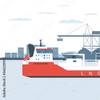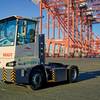Seaway Cargo Shipments Up 21% in July
Port of Green Bay sees increase in petroleum exports.
Washington, D.C. (August 18, 2011) – The St. Lawrence Seaway statistics for the month of July indicate steady traffic with cautious optimism as the economy continues to rebound.
Year-to-date total cargo shipments through July were 17 million metric tons, up 7.3 percent over the same period in 2010 due primarily to demand for bulk materials used in construction, salt, petroleum products, and Canadian grain.
Year-to-date salt tonnage increased 46 percent over the same period last year to 1.2 million metric tons as North American cities continued to replenish their reserves for road salting next winter. Year-to-date stone shipments continued strongly at 286,000 metric tons. Iron ore saw a 7.7 percent increase in the month of July to just over one million metric tons. Canadian grain increased by 60 percent in July compared to the same month in 2010, pushing the year-to-date total to 2.7 million metric tons. U.S. grain shipments dropped in July to 85,000 metric tons.
Petroleum products saw a surge of 141 percent to 1.5 million metric tons, more than double the 624,000 metric tons transported in 2010. One port that has benefitted from this surge is the Port of Green Bay.
“A long-term strategy of the Port of Green Bay has been the diversification of cargo to allow us to more evenly weather changing economic conditions,” said Port of Green Bay Manager Dean Haen. “Since 2006, the port has opened two terminals moving completely new commodities through each. One facility moves forest products and heavy lift cargo, and the other is moving petroleum products.”
“An increase in our July numbers reflects domestic and foreign exports of petroleum products. We have shipped ethanol, diesel and gasoline to Canada and the Upper Peninsula of Michigan. The shipments to Montreal and the Sarnia region of Canada have helped them to meet their supply needs caused by scheduled plant maintenance,” explained Haen. “In July we shipped 30,473 metric tons north of the border, and 14,606 metric tons to Michigan.”
He further stated, “As fuel and land based transportation costs continue to rise, along with increased road congestion, Wisconsin’s ports are well-positioned to keep our economy growing by providing a low cost transportation alternative that today’s businesses are looking for.”
One Green Bay tenant agrees. “The Port of Green Bay has provided our U.S. Oil division an excellent distribution opportunity,” states John Schmidt, CEO of U.S. Venture. “With the construction of a new dock at our Green Bay bulk petroleum terminal, marine shipping has enabled us to pursue growth of our fuel distribution business beyond our traditional modes of pipeline, truck and rail.”
“The St. Lawrence Seaway plays a critical role in moving North American products to local customers and those around the world,” said Terry Johnson, Administrator of The Saint Lawrence Seaway Development Corporation. “Not only does the Seaway provide a cost-effective, efficient and safe route for cargo to be transported globally, it allows the ports to have the ability to be nimble when responding to changing customer needs due to crop disasters, plant closures, or fluctuations in world markets. The flexibility of the Seaway, as shown over the past 50 years, is a testament to its continuing viability to support businesses, and jobs, throughout the Great Lakes.”














